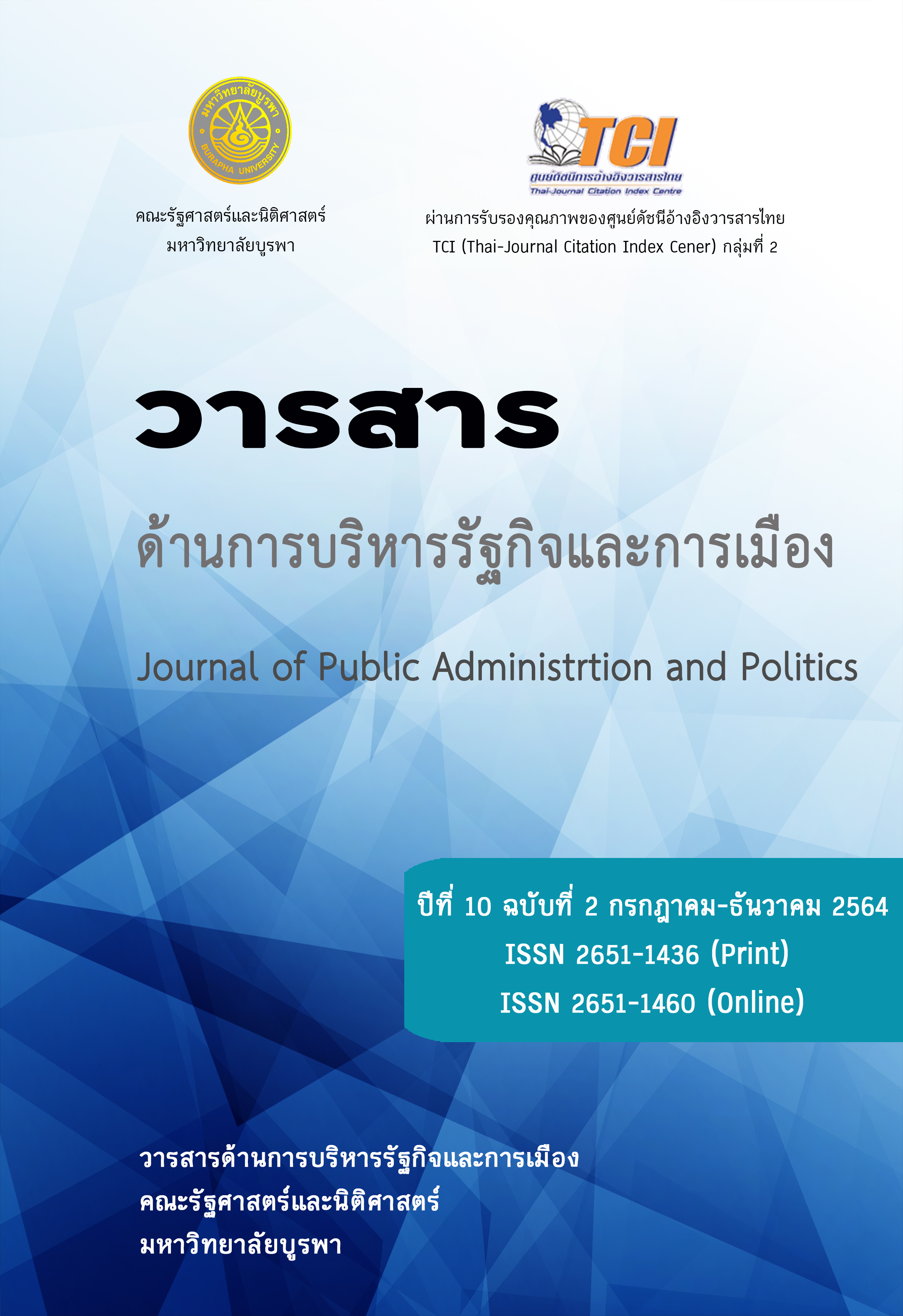The Management of Traditional Thai Desserts to Promote Souvenir Business in Phetchaburi
Main Article Content
บทคัดย่อ
การวิจัยครั้งนี้มีวัตถุประสงค์ก็เพื่อ ศึกษาถึงแนวทางการจัดการขนมไทยพื้นบ้านโบราณเพื่อส่งเสริมธุรกิจจำหน่ายของที่ระลึก จังหวัดเพชรบุรี ภายใต้การศึกษาซึ่งมุ่งศึกษาในประเด็นที่สำคัญของตัวแปรด้านการจัดการทางการตลาดและตัวแปรด้านการจัดการทางธุรกิจสำหรับธุรกิจจำหน่ายของที่ระลึก โดยผู้วิจัยเลือกการวิจัยเชิงสำรวจสำหรับการศึกษา ด้วยแบบสอบถามสำหรับกลุ่มตัวอย่างซึ่งเป็นนักท่องเที่ยว จำนวน 300 คน ที่มาใช้บริการเลือกซื้อสินค้าขนมไทยพื้นบ้านโบราณในธุรกิจจำหน่ายของที่ระลึก จังหวัดเพชรบุรี พร้อมกับการคำนวณและวิเคราะห์ด้วยการใช้แบบจำลองโครงสร้างกำลังสองน้อยที่สุดบางส่วน สำหรับผลการของการวิจัยพบว่าทั้งตัวแปรในด้านการจัดการทางการตลาดและตัวแปรด้านการจัดการทางธุรกิจล้วนมีความสำคัญต่อการจัดการขนมไทยพื้นบ้านโบราณเพื่อส่งเสริมธุรกิจจำหน่ายของที่ระลึก จังหวัดเพชรบุรี โดยเพื่อศึกษาเชิงลึกพบว่า กิจกรรมส่งเสริมการขาย (promotion) เป็นตัวแปรย่อยที่มีอิทธิพลทางตรงมากที่สุดของตัวแปรในด้านการจัดการทางการตลาด โดยมีค่าอิทธิพลที่ 0.955 และในขณะเดียวกัน การจัดการสิ่งอำนวยความสะดวก (amenity) เป็นตัวแปรย่อยที่มีอิทธิพลทางตรงมากที่สุดของตัวแปรด้านการจัดการทางธุรกิจ โดยมีค่าอิทธิพลที่ 0.970 ทั้งนี้อาจกล่าวโดยมีนัยยะได้ว่าภายใต้หนทางของการบริหารจัดการขนมไทยพื้นบ้านโบราณให้ประสบความสำเร็จสำหรับธุรกิจจำหน่ายของที่ระลึกนั้น ผู้ประกอบการจำต้องต้องให้ความตระหนักรู้ มีความใส่ใจในการจัดงานด้านกิจกรรมส่งเสริมการขาย เช่น สัปดาห์ส่งเสริมการขาย สินค้าราคาพิเศษเฉพาะช่วงและแคมเปญพิเศษต่าง ๆ เป็นต้น พร้อม ๆ กับการจัดการด้านสิ่งอำนวยความสะดวก เช่น พื้นที่จอดรถ ห้องน้ำ สถานที่และสิ่งอำนวยความสะดวกสำหรับผู้มีความต้องการพิเศษ เป็นต้น ทั้งนี้ก็เพื่อให้นักท่องเที่ยวได้รับประโยชน์อันนำมาซึ่งประโยชน์สูงสุดของธุรกิจในที่สุด
Article Details
เอกสารอ้างอิง
2.Babin, B., Anderson, R. E., Hair, J. F., & Black, B. (2006). Multivariate Data Analysis (6th Ed). New Jersey: Prentice Hall.
3.Chin, W. W. (1998). The partial least squares approach for structural equation modeling. In G. A. Marcoulides (Ed.), Modern Methods for Business Research (pp. 295-236). London: Lawrence Erlbaum Associates.
4.Choi, S., & Kim, D. (2010). 5A study on impact between customer satisfaction and re-purchase service quality of foreign tourism products. Journal of the Korea Academic-Industrial Cooperation Society, 11(8), 2853-2859.
5.Chonnapastit, W. (2009). sustainability of SME business operation: a case study of dessert business in Phetchaburi province. Modern Management Journal, 7(2), 53-68.
6.Deeti, V. (2019). 5 Main Components of a Better Tourism Product. Retrieved April 5, 2020,from http://www.shareyouressays.com/knowledge/5-main-components-of-a-better-tourism-product/93564
7.Dickman, S. (1996). Tourism: an Introductory Text. Sydney: Hodder Education.
8.Economic Tourism and Sports Division. (2019). The Provincial Tourism Statistics 2018. Retrieved April 5, 2020, from http://phetburi.nso.go.th/index.php?option=com_content&view=article &id=190:-4-&catid=83:2011-10-11-07-22-06
9.Etzel, M. J., Walker, B. J., & Stanton, W. J. (2004). Marketing. Boston: McGraw-Hill Irwin.
10.Hair, J. F., Ringle, C. M., & Sarstedt, M. (2011). PLS-SEM: indeed a silver bullet. Journal of Marketing Theory & Practice, 19(2), pp. 139-151.
11.Hinkle, D. E., Wiersma, W. & Jurs, S. G. (1998). Applied Statistics for the Behavior Sciences (4th Ed). New York: Houghton Mifflin.
12.Hongsirikarn, K., Wongvanichtawee, C., & Santisarn, B. (2020). Characteristics of successful startup leadership in Thailand. Journal of Politics, Administration and Law, 12(1), 262-278.
Horner, S. & Swarbrooke, J. (2004). Consumer Behavior in Tourism. Burlington, MA: Butterworth-Heinemann.
13.Kline, R. B. (1998). Principles and Practice of Structural Equation Modeling. New York: Guilford Press.
14.Kotler, P. (2000). Hospitality Marketing. New Jersey: Prentice-Hall.
15.Li, F., & Ryan, C. (2018). Souvenir shopping experiences: A case study of Chinese tourists in North Korea. Tourism Management, 64(C), 142-153.
16.Lin, J. H., Chang, Y. T., & Tsai, Y. R. (2018). Exploring the locality and meaning of tourist souvenirs: evidence from Taiwan. In Vopava, J., Douda, V., Kratochvil, R., & Konecki, M. (Eds.), Proceedings of the 12th Multidisciplinary Academic Conference (The 12th MAC 2018), March 2-3, 2018 (pp.76-82). Prague, Czech Republic: Academic Conferences Association.
17.Middleton, V. T. C. (1994). Marketing in Travel Tourism. Oxford: Butterworth-Heinemann.
18.Murnpho, S. (2019). Study on purchase decision of customers on goods of People with Disabilities (PWDs). Journal of Politics, Administration and Law, 11(1), 123-138.
19.Phespasert, S., & Anomasiri, V. (2020). The participation of tourism business entrepreneurs on Lamtakong Canal Conservation in Pakchong District, Nakhon Ratchasima Province. Journal of Politics, Administration and Law, 12(1), 397-413.
20.Phetchaburi Provincial Statistical Division. (2019). The Statistic of Travel Business. Retrieved April 5, 2020, from http://phetburi.nso.go.th/index.php?option=com_content&view=article&id=190:-4-&catid=83:2011-10-11-07-22-06
21.Plog, S. (1977). Why destination areas rise and fall in popularity. In Kelly, E., (Ed), Domestic and International Tourism. Wellsbury, MA.: Institute of Certified Travel Agents.
22.Ratanasuwanachart, N., Rudchoochip, K., & Wongthongdee, S. (2019). Innovation management. Journal of Politics, Administration and Law, 11(3), 543-554.
23.Roseman, S. R., & Fife, W. (2008). Souvenirs and cultural politics in Santiago de Compostela. International Journal of Iberian Studies, 21(2), 109–130.
24.Schmoll, G. A. (1977). Tourism Promotion : Marketing Background, Promotion Techniques and Promotion Planning Methods. London: Tourism International.
25.Smith, S. L. J. (1996). Tourism Analysis: A Handbook (2nd Ed). Englewood Cliffs, NJ.: Prentice-Hall.
26.Swanson, K. K., & Timothy, D. J. (2012). Souvenirs: icons of meaning, commercialization and commoditization. Tourism Management, 33(3), 489-499.
27.Tourism Western Australia. (2008). Five A's of Tourism. Australia: Tourism Western Australia.
28.Wanichbancha, K. (2003). Using SPSS for Windows to Analyze Data (6th ed.). Bangkok: Thammasan.
29. Yeh, T., Chen, S., & Chen, T. (2019). The relationships among experiential marketing service innovation, and customer satisfaction-a case study of tourism factories in Taiwan. Sustainability, 11(1041), 1-12.


